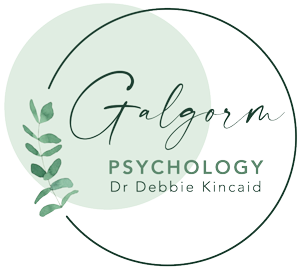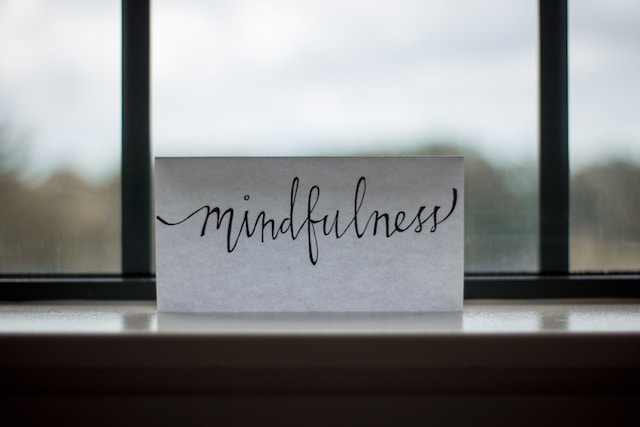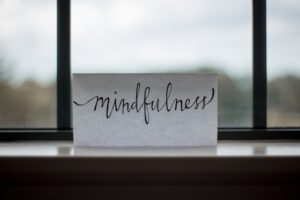What are grounding techniques?
Grounding is a helpful, evidence-based strategy to help us stay connected to the present moment. When we feel anxious, our mind will often be focused on thoughts about the future and what ‘could’ or ‘might’ happen. Using grounding strategies can be helpful to keep us connected to the here-and-now, which in turn can help us feel calmer. These techniques could also be thought of as a way of ‘centring’ yourself.

Grounding strategies for trauma and Post Traumatic Stress Disorder (PTSD)
One of the distressing symptoms of trauma is the re-experiencing of past events. This might be in the form of a ‘flashback’ (whereby it feels like you are back in the scenario reliving it), nightmares (which may or may not appear similar to the traumatic experience), or ‘intrusive thoughts’ (thoughts or memories of event(s) which pop into the mind uninvited and cause distress). Grounding techniques are simple strategies which can help us refocus our attention, and this can be particularly helpful when we experience flashbacks or intrusive thoughts. Using these techniques can help us cope with trauma symptoms, and keep us connected to the present moment, rather than connected to the past.
Experiencing a traumatic event can also lead to another symptom called ‘dissociation’. Dissociation is the experience of disconnection from the present moment, whereby we might experience a sense of detachment, numbness or a loss of touch with the here-and-now. Grounding techniques can keep us connected to the present moment or help us move back into the present when we lose touch with it.
Does Grounding help with anxiety, trauma and PTSD symptoms?
Grounding techniques are evidence-based strategies which can help to manage the symptoms of trauma and anxiety disorders. It does not directly address the problem which is bringing about difficult thoughts, emotions or bodily sensations, however it does provide a way of coping with symptoms and gaining a sense of control over symptoms.
Grounding techniques can help us ‘pull away’ from distressing intrusive thoughts or flashbacks and prevent things from getting any worse. They offer a way of distracting ourselves from distressing thoughts and feelings by refocusing our attention on the present moment (where the distressing memories are not happening right now). These exercises can help us to feel calmer and safer. They can help us find a balance between states of numbness and emotional overwhelm, and therefore enhance our emotional regulation. Grounding skills can also help build a foundation to begin working on the problem which is causing the symptoms.
Types of grounding strategies
There are a number of possible ways of grounding yourself however most grounding strategies fall within three broad categories:
*Mental techniques
*Physical techniques
*Soothing techniques
Mental Grounding Techniques
- Describe your surroundings in detail (attend to what you can see, hear, smell etc.)
- Count objects of a particular colour
- Notice what is different in the here and now compared to the time of the trauma
- Name an animal beginning with each letter of the alphabet
- Count backwards from 200 in 7’s
- Remind yourself you that you are safe here in the present
Physical Grounding Techniques
- Hold an object (a smooth stone/ a picture of a loved one)
- Smell something (essential oils, pillow mist spray, a candle)
- Taste a strong flavour (strong mints, sour sweets)
- Push your feet into the ground, and feel it supporting you
- Wash your hands (or face) with cold water
- Touch items nearby and notice their texture and temperature
- Walk barefoot on grass
Soothing Grounding Techniques
- Talk kindly to yourself (the way you would speak to a friend who was struggling)
- Spend time with an animal
- Focus on your favourite song/ poem/ quote/ prayer
- Take a shower/ bath using your favourite soap
- Think about your favourite things (people, TV shows, animals, activities)
- Visualise a safe, calm place (tropical island, forest, mountains)
Using the techniques effectively
You can choose to use grounding techniques at anytime, anywhere (well, almost). Most techniques can be very subtle so no-one needs to know that you are using this coping skill. You can be using them sitting at your desk at work, waiting in the car, before meeting a friend, or whilst out a walk.
Try out different types of exercises and see what works for you. It can be helpful to practice different strategies in order to build a ‘toolkit’ of grounding skills, and so that you can put this skill into practice when needed. You may find that one style of grounding works best for you, or you may find benefit from all types at different times.
Supporting yourself to use grounding skills
Try to make it easy for yourself to remember to practice grounding techniques when feeling calm, and also to utilise these techniques when high distress is triggered. Place reminders around your home such as post it notes in visible places or use a photo of a list of grounding strategies as your phone screensaver.
Place items such as essential oils, pillow sprays, mints etc around your home or the car (or work desk) to act as a visual reminder to practice grounding. It is really helpful to have items nearby when feeling overwhelmed and when it is difficult to think what to do.
It can also be useful to teach others around us about grounding skills. They can help remind you to try a grounding technique if they notice that you appear ‘distant’ or overwhelmed by past memories. Try to use grounding strategies as soon as you notice distress arising or disconnection occurring as this is when we have most control over the feeling and our reactions.
Be mindful that any smell, sound, sensation, taste, sight or thing has the potential to be unhelpful as a grounding strategy if it reminds you of some aspect of a past trauma. Avoid using anything which reminds you of a traumatic event, and instead try to find an alternative grounding strategy which helps emphasise the difference between the past and the present.
Have a go trying out some of the grounding ideas listed above or develop your own techniques. Notice how you feel after using each technique and make a list of the most helpful ones for you.
If you are experiencing trauma symptoms and would like to learn more about coping with symptoms, please have a look at the free resources section of this website for further information or click here to contact me to find out more about my services.
If you found this article interesting, check out the following article on mindfulness for further helpful ideas.
© 2023 Galgorm Psychology


